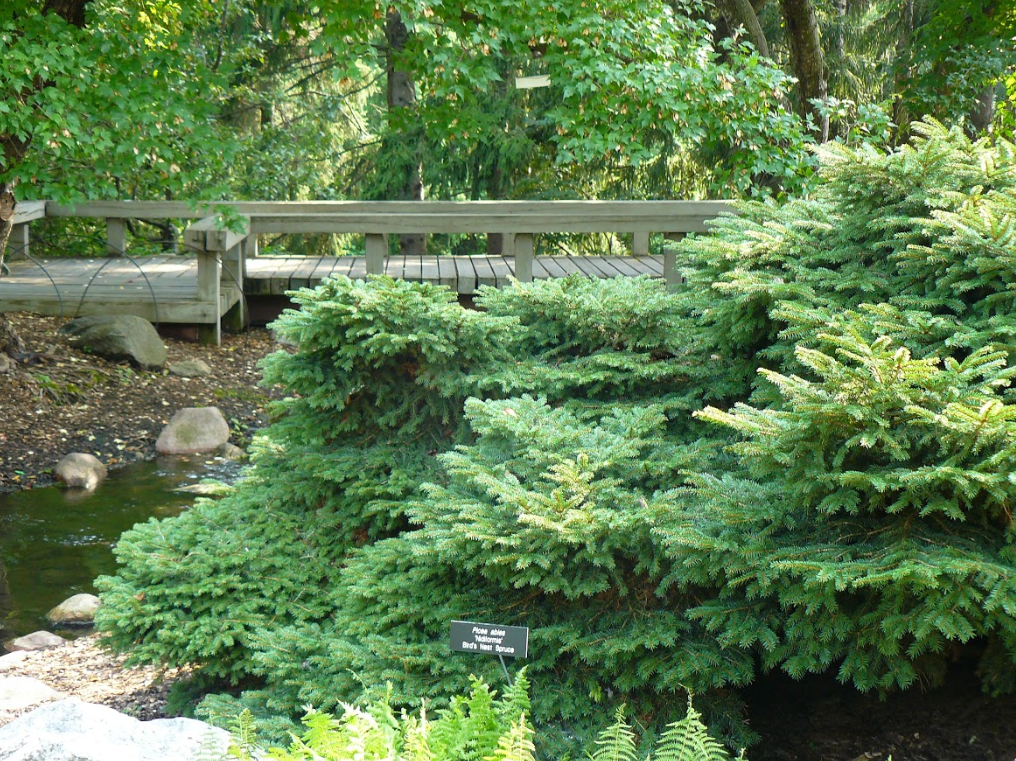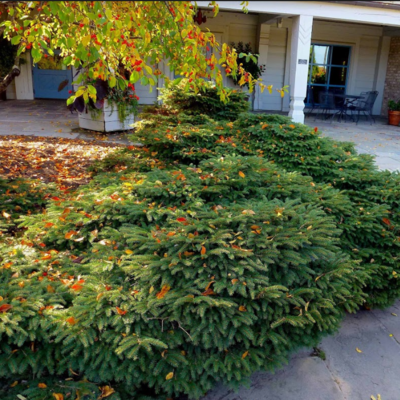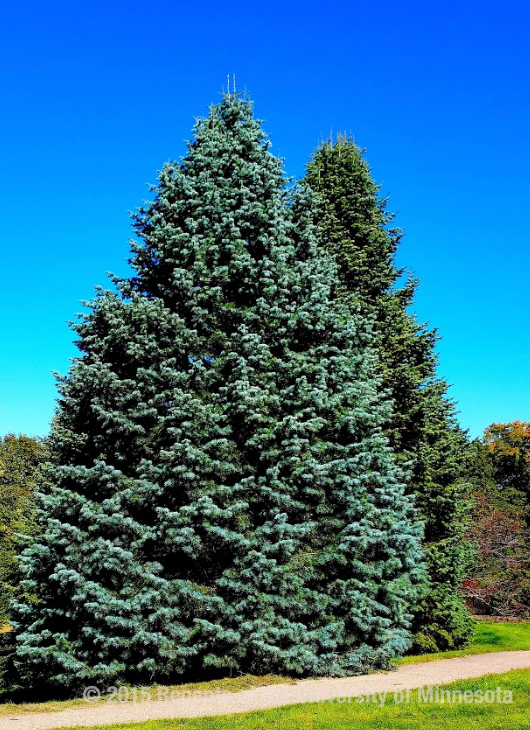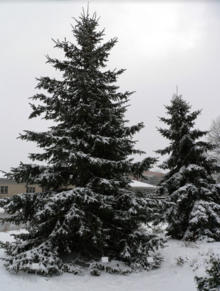Pine Trees in Indiana How to Make Healthy Again
Quick facts
- Foliage color, lack of flowering or overall vigor tin can be signs of when fertilizer is needed.
- If growth rate and needle color are normal for a detail multifariousness, fertilization is non necessary.
- It is not unusual for newly transplanted evergreens to showroom tiresome growth until they're re-established.
- In many landscapes, evergreens likewise do good from fertilizer you apply to the lawn.
Like all landscape plants, evergreens require nutrients to grow well. While evergreens mostly require less fertility than deciduous copse and get some nutrients from soil, at some point you might demand to fertilize your evergreens.
A soil test volition provide a base of information almost your soil and the fertilizer analysis you will need for your plants.
When to fertilize
- New growth is thin or wearisome.
- Needles are not a healthy green colour, or are shorter than normal.
- You lot are trying to grow evergreens in a less than ideal site, such as very sandy or heavy clay soil.
- The plant has suffered pregnant damage from insects or illness.
- You wish to encourage more than rapid growth in relatively immature evergreens.
Evergreens provide great diversity in form, color and size.
Fertilizer packages will include an analysis of the percentage of diverse nutrients and minerals that are included in the bag.
- A "complete" fertilizer — one that supplies the macronutrients nitrogen (N), phosphorus (P), and potassium (K) — is oft recommended.
- The three numbers on the fertilizer bag stand for the percentage of N-P-K
- A fertilizer analysis of x-8-xv means the fertilizer has 10 pct nitrogen, 8 percent phosphorous, and 15 percent potassium.
- Usually the pct of nitrogen content (Due north) will be the highest number. Nitrogen is a mobile nutrient that leaches through soil and needs to exist replenished most ofttimes.
It is ever all-time to submit a soil sample to the University of Minnesota Soil Testing Laboratory earlier purchasing and applying fertilizer, as most soil already has sufficient amounts of phosphorus.
Soil pH
Test results will also provide information about your soil'southward pH (vii.0 is neutral, less than vii.0 is acidic, and higher than seven.0 is alkaline). The soil pH can affect whether certain minerals can be accessed past plants for healthy growth. Mostly, evergreens grow amend when soil pH is acidic; many nutrients may be unavailable to the found when soil is as well element of group i.
The all-time fourth dimension to fertilize your evergreens is before new growth expands, around early Apr in Minnesota, up to most mid-July.
- Don't apply fertilizer after than mid-July as this will stimulate new growth tardily in the flavour.
- This new growth may not have fourth dimension to "harden off" (become acclimated to colder temperatures).
- New growth is much more than likely to suffer winter injury and dieback. Run across Protecting trees and shrubs from winter harm.
- If a plant is food-stressed, a slow or timed-release fertilizer can be applied in late summer up until late autumn. This can help evergreens tolerate winter and emerge healthier in the spring.
- Water dry plants before fertilizing.
- Never fertilize drought-stressed plants as fertilizer can burn stressed tree roots or push button the plant to put on new growth when it does not take the energy.
- If atmospheric condition continue to be dry afterward you've fertilized (e.g. little to no rainfall), be sure to water your evergreens regularly through late fall. See H2o Wisely.
Fertilizer recommendations are unremarkably given in pounds per thousand square feet. To find out how much to utilise, figure out roughly how many square feet your tree or shrub covers. For instance a spruce that measures 5 feet across would cover 25 square anxiety.
A mutual "maintenance rate" of fertilizer is two to 4 pounds actual nitrogen per thousand square anxiety of soil surface, applied every two to four years. For mature, slower growing trees, 1 pound of actual nitrogen is probably enough.
It's easy to figure out how much actual nitrogen is in a bag of fertilizer, because the numbers in the fertilizer analysis are actual percentages, by weight.
- Case i: A xl pound bag of ten-8-6 is 10 percent nitrogen. Ten percent of xl is 4, which ways the entire pocketbook contains iv actual pounds of nitrogen (plus phosphorus, potassium, and an inert carrier).
- Example two: A 30 pound purse of 21-0-0 is 21 percent nitrogen. Twenty-one percent of 30 is six.3, which means the purse contains vi.3 pounds of actual nitrogen.
Spreader
As long as the charge per unit used is 2 pounds actual nitrogen per 1,000 foursquare anxiety or less, yous can spread the fertilizer with a drop spreader under the evergreen branches and slightly beyond, so water it in well. Any college rate would burn the grass it was spread onto, even if it were watered immediately afterward application.
If your tree is mulched, spread the fertilizer correct over the mulch and water in well. The granules will work their way down to the soil surface.
Incorporating fertilizer
A more than effective method would be to dig holes, so place fertilizer right in the holes.
- Thoroughly soak the surface area where you will fertilize to soften the soil so it's easier to make holes.
- Use a crowbar, soil auger, metallic rod or other tool to create holes roughly 2 inches in diameter. Make holes about 8 to 12 inches deep.
- Space the holes near 2 feet apart in large concentric circles, starting one 1/two anxiety from the body of immature trees or 3 feet from the torso of larger, more mature trees.
- Separate the corporeality of fertilizer needed, and place information technology as into each hole.
- And so h2o the area. There's no need to refill the holes with soil.
Using these guidelines for making the holes, the following gives y'all a brusque-cutting to determine how much fertilizer to place in each.
The amount of fertilizer to apply per pigsty will vary depending on formulation. To get approximately two pounds actual nitrogen per 1,000 square anxiety, utilise:
- two 1/2 tablespoons for a 10-8-six fertilizer
- ii tablespoons for a fourteen-14-14 fertilizer
- one 1/4 tablespoons for a 21-0-0 fertilizer
Using spikes or root feeders
Fertilizer spikes are a convenient and simple way to fertilize evergreens, and are constructive when used in sufficient quantities. Nonetheless, because each spike contains but a modest amount of fertilizer, they are not cost-effective compared to granular products.
Applying liquid fertilizer through a root feeder is some other option on all but heavy, poorly drained soil. But information technology tin also hateful additional work when practical to low-cal, sandy soil. Liquid fertilizer leaches through sandy soil speedily, and may need to exist applied several times throughout spring and early summertime. Again, this method of fertilizing, though convenient, is more costly than applying standard granular fertilizer.
Keep evergreens healthy by mulching the soil surface under their branches and slightly beyond. The mulch ring should start at the root flare (where the main tree roots signal out abroad from the trunk) and go on out from the tree trunk at almost 3 or four inches deep.
Benefits of mulch
- Mulch helps hold in soil moisture.
- Mulch insulates roots past moderating soil temperature.
- A mulch ring around a plant will protect the stem / torso from being damaged by lawnmowers and trimmers.
- Mulch gives a landscape a "finished" await.
Typically, evergreens are mulched with forest fries or shredded bark. Even so, whatever mulching material will exercise. Well-rotted manure or seasoned compost volition add a pocket-sized amount of nutrients as they break downwards further.
Never lay plastic sheeting under any kind of mulch
- Plastic sheeting will prevent water from reaching the tree roots.
- Landscape fabric or "weed barriers" are not recommended under organic mulch such equally shredded wood.
- Mulch that is deep enough (3 to four inches effectually copse and shrubs) volition prevent weed growth and adds organic matter to the soil as it breaks down.
- Landscape fabric is recommended under non-organic mulches such as rock and shredded prophylactic to forbid these materials from working their mode into the soil.
Reviewed in 2018
Source: https://extension.umn.edu/trees-and-shrubs/fertilizing-evergreens





Belum ada Komentar untuk "Pine Trees in Indiana How to Make Healthy Again"
Posting Komentar